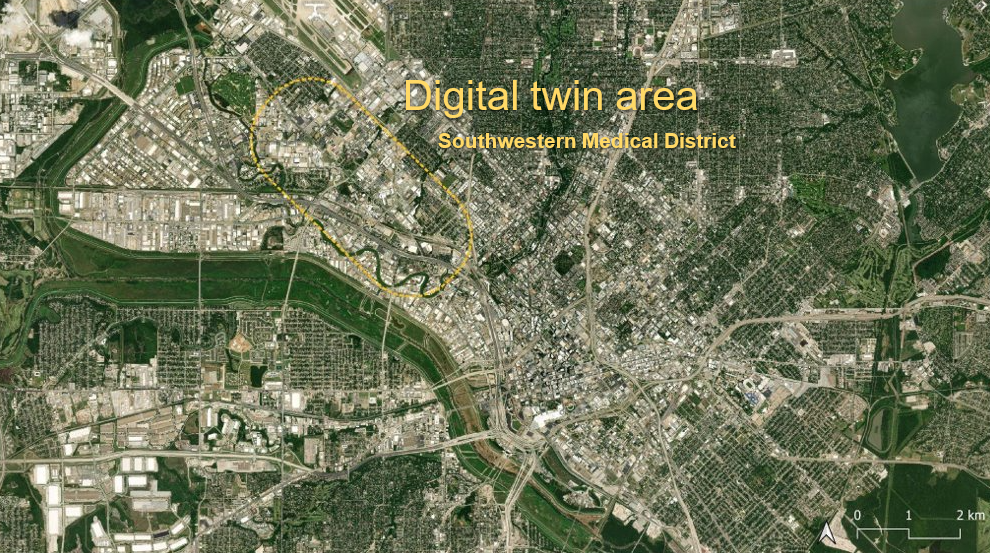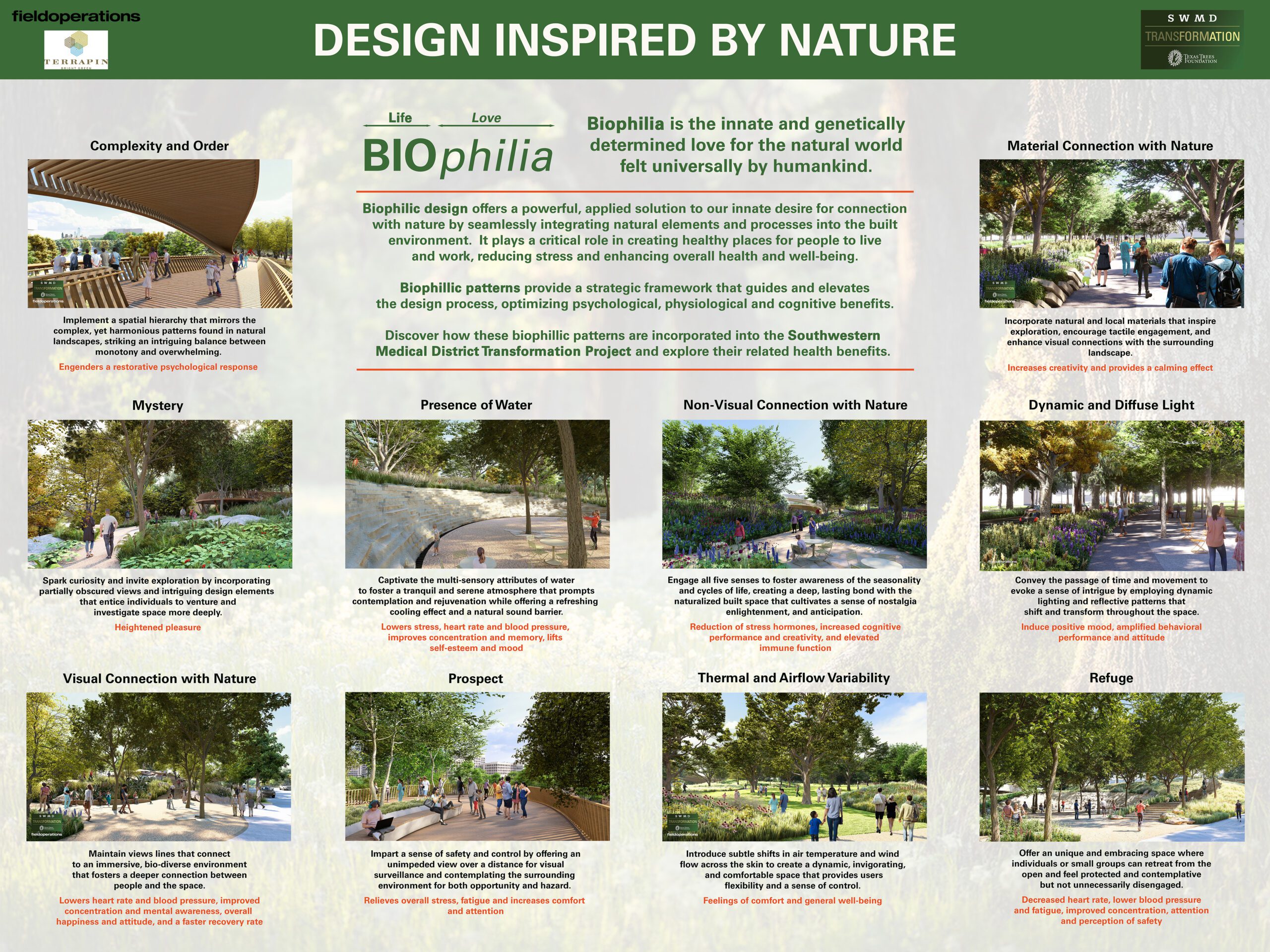A Healthy Approach To Design
The re-design planned for the Southwestern Medical District is being thoughtfully and holistically designed utilizing an evidence-based design approach; the act of marrying the disciplines of design and science by modeling, optimizing, and validating design concepts to create a space that maximizes environmental and health benefits.
Inspired by the fact that design decisions, from the large-scale design of road networks to the smaller-scale strategic planting of trees, can impact how humans feel in an environment and nature’s ability to thrive, Texas Trees Foundation is harnessing the power of science and data to inform the design of the Green Spine and the Green Park to create an environment that best serves the 3+ million people who work or seek care in this critical district annually.
Our evidence-based design approach is focused on influencing large-scale change such as decreasing the urban heat island effect for the larger Medical District via increasing its overall tree canopy cover and incorporating pockets of greenspace throughout the Green Spine and in the Green Park. However, we are also passionate about implementing small-scale design interventions at the individual pedestrian level by strategically planting trees and vegetation to maximize air pollutant filtration, increase thermal comfort, and leverage prevailing winds to create a comfortable, safe, and cooler environment.
Healthy environments
influence health outcomes.
The scope of impact for the project is not limited to just the Southwestern Medical District. The team and our partners believe that this project has the potential to inspire other design projects across the globe to harness the power of science and data to design urban environments that best serve people's health and well-being and steward the natural environments where they live, work, and play.
Our evidence-based design work is the first pilot project across the United States done at this scale and scope, and we hope that this step-by-step process will allow us to understand environmental health metrics at scale and to model and validate design responses before implementation.
The project team has collaborated with bio-ecological firm, Hyphae Design Laboratory, for their expertise in establishing our evidence-based design approach. Our evidence-based design approach has followed the below structure.
“The Designer does not begin with some preconceived idea. Rather, the idea is the result of careful study and observation, and the design, a product of that idea” - Paul Bland
Our Evidence-Based Design Approach
MEASURE:
Utilize technology to capture high resolution satellite images of the Medical District. In Summer 2023, the Texas Trees Foundation, assisted by our partners at Hyphae Design Laboratory deployed 58 microclimatic sensors at key locations throughout the Harry Hines Corridor to capture real-time data of environmental conditions including globe temperature, air temperature, humidity, wind-speed, and wind-direction, all factors that influence the Universal Thermal Comfort Index, or how humans’ bodies experience their microclimatic environment given the environmental conditions outlined above.

Next time you’re walking to or from a shift, medical appointment, or simply passing through the Medical District, see if you can spot the sensors in action! You can find them attached to trees, traffic, electrical, or light poles, or signage along Harry Hines Boulevard.
MODEL:
A “digital twin” model of the Southwestern Medical District’s terrain, buildings, existing vegetation, and surface materials was created.

MODIFY:
Using the data from the sensors as input, multiple scenarios are being run on the “digital twin” model of the District to identify the best design interventions the team can administer to yield the greatest human health and comfort indexes. For example, the team can strategize tree canopy cover to provide increased shade near high foot traffic areas and can design tree planting layouts of mixed density which simultaneously promote wind flow and provide opportunities for shade and air pollution buffering to create a comfortable and safe pedestrian experience.

A Reimagined Streetscape for the Southwestern Medical District
A COOLER STREET
Sun and shade analysis drove the boulevard planting design. Studies revealed very little shade is created by typical street trees. An innovative planting approach that incorporates groves of trees was developed to maximize shade and cooling. Performance analysis indicates this strategy will lower temperatures by as much as 15 degrees along the sidewalks.

A CLEANER STREET
Prevailing winds blow air pollution and particulate matter from vehicles on Harry Hines Blvd. to the east, creating a disproportionate burden on this side of the street. The cycle track is located upwind to avoid the pollution, and the downwind sidewalk is protected by a heavily planted berm. The result is a reduction in particulate matter impacting pedestrians and cyclists.

A GREENER STREET
The corridor is divided by a large median that will be narrowed down to allow pedestrians, especially those with disabilities, easier access across Harry Hines Boulevard. Healthy, mature trees that grace the back of curb area will be supplemented with newer trees that provide a greater biodiversity and capture air pollutants.

A HEALTHIER STREET
The vision of the Southwestern Medical District Urban Streetscape and Park Project is to create a livable district that emphasizes and supports a healthy environment, healthy systems, and healthy people. Texas Trees Foundation worked closely with our partners in the Medical District and the community to develop guiding goals within these 3 "healthy" categories. Enlarge the photo to explore where and how we will holistically impact the health of the Medical District along the Green Spine and in the Green Park.
The Texas Trees Foundation and our partners are employing biophilic design principles in the SWMD Streetscape and Park Transformation to create a space where all people can thrive. Elements of biophilia will allow users of the Green Spine and Green Park to find respite, peace, joy, and connection in their surroundings through the intentional integration of nature into the built environment. Click the photo to learn more, and visit our partner, Terrapin Bright Green's website to learn more about biophilic design and explore their vast body of research on this topic.


